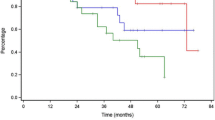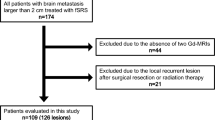Abstract
After radiosurgery of malignant tumors, it can be difficult to discriminate between transient treatment effects, radiation necrosis, and tumor progression on post-treatment imaging. Misinterpretation of an enlarging lesion may lead to inappropriate treatment and contribute to disagreements about treatment efficacy. In an effort to clarify this problem, we reviewed our experience with interpreting post-radiosurgical imaging in patients with malignant primary and secondary brain tumors. We reviewed results of radiosurgery of 30 malignant gliomas and 35 metastatic brain tumors with minimum follow up of 1 year or until death. Of 30 gliomas, 73% were larger a mean of 13 weeks after radiosurgery. Of 35 metatstatic tumors, 22% were larger a mean of 10 weeks after radiosurgery. Eleven had 18F-fluorodeoxyglucose-positron emission tomography (FDG-PET) of enlarging lesions. Eight showed increased activity with respect to brain; three decreased activity. Of the eight, six predicted incorrectly based upon the patients' subsequent courses (all alive, mean follow up of 27 months), and two correctly, with the patients dying from the imaged lesions 8 and 13 months later. Of the three with FDG uptake less than brain, one patient was alive with 32 weeks of follow up, and two patients died from the imaged lesion 13 and 21 months later. Radiographic enlargement after radiosurgery is common, especially for gliomas. Physicians caring for these patients should be aware of this phenomenon and be cautious in interpreting post-treatment images. MRI appearance may be useful for metastases. FDG-PET seems unreliable. Further evaluation of Tl-201 and HMPAO SPECT or MRS is warranted.
Similar content being viewed by others
References
Alexander E III, Moriarty TM, Davis RB, Wen PY, Fine HA, Black PM, Kooy HM, Loeffler JS: Stereotactic radiosurgery for the definitive, noninvasive treatment of brain metastases. J Natl Cancer Inst 87: 34-40, 1995
Auchter RM, Lamond JP, Alexander E III, Buatti JM, Chappell R, Friedman WA, Kinsella TJ, Levin AB, Noyes WR, Schultz CJ, Loeffler JS, Mehta MP: A multiinstitutional outcome and prognostic factor analysis of radiosurgery for resectable single brain metastases. Int J Radiat Oncol Biol Phys 35: 27-35, 1996
Flickinger JC, Lunsford LD, Somaza S, Kondziolka D: Radiosurgery: Its role in brain metastasis management. Neurosurg Clin North America 7: 497-504, 1996
Kihlstrom L, Karlsson B, Lindquist C: Gamma knife surgery for cerebral metastasis: implications for survival based on 16 years experience. Stereotact Func Neurosurg 61(Suppl): 45-50, 1993
Loeffler JS, Kooy HM, Wen PY, Fine HA, Cheng C-W, Mannarino EG, Tsai JS, Alexander E III: The treatment of recurrent brain metastases with stereotactic radiosurgery. J Clin Oncol 8: 576-582, 1990
Mehta MP, Rozental JM, Levin AB, Mackie TR, Kubsad SS, Gehring MA, Kinsella TJ: Defining the role of radiosurgery in the management of brain metastases. Int J Radiat Oncol Biol Phys 24: 619-625, 1992
Shu H-KG, Sneed PK, Shiau C-Y, McDermott MW, Lamborn KR, Park E, Ho M, Petti PL, Smith V, Verhey LJ, Wara WM, Gutin PH, Larson DA: Factors influencing survival after gamma knife radiosurgery for patients with single and multiple brain metastases. Cancer J Sci Am 2: 335-342, 1996
Brada M, Laing R: Radiosurgery/stereotactic external beam radiotherapy for malignant brain tumors: The Royal Marsden Hospital experience. Recent Results Cancer Res 135: 91-104, 1994
Kondziolka D, Flickinger JC, Bissonette DJ, Bozik M, Lunsford LD: Survival benefit of stereotactic radiosurgery for patients with malignant glial neoplasms. Neurosurgery 41: 776-785, 1997
Mehta MP, Masciopinto J, Rozental J, Levin A, Chappell R, Bastin K, Miles J, Turski P, Kubsad S, Mackie T, Kinsella T: Stereotactic radiosurgery for glioblastoma multiforme: Report of a prospective study evaluating prognostic factors and analyzing long-term survival advantage. Int J Radiat Oncol Biol Phys 30: 541-549, 1994
Shrieve DC, Alexander E III, Wen PY, Fine HA, Kooy HM, Black PM, Loeffler JS: Comparison of stereotactic radiosurgery and brachytherapy in the treatment of recurrent glioblastoma multiforme. Neurosurgery 36: 275-284, 1995
Carvalho PA, Schwartz RB, Alexander E III, Garada BM, Zimmerman RE, Loeffler JS, Holman BL: Detection of recurrent gliomas with qualitative thallium-201/technetium 99m HMPAO single-photon emission computerized tomography. J Neurosurg 77: 565-570, 1992
Schwartz RB, Carvalho PA, Alexander E III, Loeffler JS, Folkerth R, Holman BL: Radiation necrosis vs highgrade recurrent glioma: differentiation by using dualisotope SPECT with 201Tl and 99mTc-HMPAO. AJNR 12: 1187-1192, 1991
Schwartz RB, Holman BL, Polak JF, Barada BM, Schwartz MS, Folkerth R, Carvalho PA, Loeffler JS, Shrieve DC, Black PM, Alexander E III: Dual-isotope single-photon emission computerized tomography scanning in patients with glioblastoma multiforme: association with patient survival and histopathological characteristics of tumor after high-dose radiotherapy. J Neurosurg 89: 60-68, 1998
Harris OA, Adler JR: Analysis of the proliferative potential of residual tumor after radiosurgery for intraparenchymal brain metastases. J Neurosurg 85: 667-671, 1996
Bindal AK, Bindal RK, Hess KR, Shiu A, Hassenbusch SJ, Shi WM, Sawaya R: Surgery versus radiosurgery in the treatment of brain metastasis. J Neurosurg 84: 748-754, 1996
Ott K: Surgery or Radiosurgery? J Neurosurg 86: 165-166, 1997 (Letter)
Fraass BA: The development of conformal radiation therapy. Med Phys 22(11 Pt 2): 1911-1921, 1995
McShan DL, Fraass BA, Lichter AS: Full integration of the beam's eye view concept into computerized treatment planning. Int J Radiat Oncol Biol Phys 18(6): 1485-1494, 1990
Archer PG, Balter JM, Sandler HM, Hayman JA, Ross DA: The treatment planning of segmental, conformal stereotactic radiosurgery utilizing a standard multi-leaf collimator. Med Dosimetry 24: 13-19, 1999
Engenhart R, Kimmig BN, Hover K-H, Wowra B, Romahn J, Lorenz WJ, van Kaick G, Wannenmacher M: Longterm follow-up for brain metastases treated by percutaneous stereotactic single high-dose irradiation. Cancer 71: 1353-1361, 1993
Peterson AM, Meltzer CC, Evanson EJ, Flickinger JC, Kondziolka D: MR imaging response of brain metastases after gamma knife stereotactic radiosurgery. Radiology 211: 897-814, 1999
Adler JR, Cox RS, Kaplan I, Martin DP: Stereotactic radiosurgical treatment of brain metastases. J Neurosurg 76: 444-449, 1992
Thompson TP, Lunsford LD, Kondziolka D: Distinguishing recurrent tumor and radiation necrosis with positron emission tomography versus stereotactic biopsy. Stereotact Funct Neurosurg 73: 9-14, 1999
Matheja P, Rickert C, Weckesser M, Hoss N, Schober O: Scintigraphic pitfall: delayed radionecrosis. J Neurosurg 92: 732, 2000
Lin A, Bluml S, Mamelak AN: Efficacy of proton magnetic resonance spectroscopy in clinical decision making for patients with suspected malignant brain tumors. J Neuro-Oncol 45: 69-81, 1999
Author information
Authors and Affiliations
Rights and permissions
About this article
Cite this article
Ross, D.A., Sandler, H.M., Balter, J.M. et al. Imaging Changes after Stereotactic Radiosurgery of Primary and Secondary Malignant Brain Tumors. J Neurooncol 56, 175–181 (2002). https://doi.org/10.1023/A:1014571900854
Issue Date:
DOI: https://doi.org/10.1023/A:1014571900854




